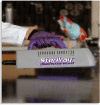Evaluation of a hand-held far-ultraviolet radiation device for decontamination of Clostridium difficile and other healthcare-associated pathogens
- PMID: 22591268
- PMCID: PMC3419611
- DOI: 10.1186/1471-2334-12-120
Evaluation of a hand-held far-ultraviolet radiation device for decontamination of Clostridium difficile and other healthcare-associated pathogens
Abstract
Background: Environmental surfaces play an important role in transmission of healthcare-associated pathogens. There is a need for new disinfection methods that are effective against Clostridium difficile spores, but also safe and rapid. The Sterilray™ Disinfection Wand device is a hand-held room decontamination technology that utilizes far-ultraviolet radiation (185-230 nm) to kill pathogens.
Methods: We examined the efficacy of disinfection using the Sterilray device in the laboratory, in rooms of hospitalized patients, and on surfaces outside of patient rooms (i.e. keyboards and portable medical equipment). Cultures for C. difficile, methicillin-resistant Staphylococcus aureus (MRSA), and vancomycin-resistant Enterococcus (VRE) were collected from commonly-touched surfaces before and after use of the Sterilray device.
Results: On inoculated surfaces in the laboratory, application of the Sterilray device at a radiant dose of 100 mJ/cm(2) for ~ 5 seconds consistently reduced recovery of C. difficile spores by 4.4 CFU log10, MRSA by 5.4 log(10)CFU and of VRE by 6.9 log10CFU. A >3 log10 reduction of MRSA and VRE was achieved in ~2 seconds at a lower radiant dose, but killing of C. difficile spores was significantly reduced. On keyboards and portable medical equipment that were inoculated with C. difficile spores, application of the Sterilray device at a radiant dose of 100 mJ/cm(2) for ~ 5 seconds reduced contamination by 3.2 log10CFU. However, the presence of organic material reduced the lethal effect of the far-UV radiation. In hospital rooms that were not pre-cleaned, disinfection with the Sterilray device significantly reduced the frequency of positive C. difficile and MRSA cultures (P =0.007).
Conclusions: The Sterilray™ Disinfection Wand is a novel environmental disinfection technology that rapidly kills C. difficile spores and other healthcare-associated pathogens on surfaces. However, the presence of organic matter reduces the efficacy of far-UV radiation, possibly explaining the more modest results observed on surfaces in hospital rooms that were not pre-cleaned.
Figures


Similar articles
-
Evaluation of an automated ultraviolet radiation device for decontamination of Clostridium difficile and other healthcare-associated pathogens in hospital rooms.BMC Infect Dis. 2010 Jul 8;10:197. doi: 10.1186/1471-2334-10-197. BMC Infect Dis. 2010. PMID: 20615229 Free PMC article.
-
Sorting through the wealth of options: comparative evaluation of two ultraviolet disinfection systems.PLoS One. 2014 Sep 23;9(9):e107444. doi: 10.1371/journal.pone.0107444. eCollection 2014. PLoS One. 2014. PMID: 25247783 Free PMC article.
-
Evaluation of a pulsed xenon ultraviolet disinfection system for reduction of healthcare-associated pathogens in hospital rooms.Infect Control Hosp Epidemiol. 2015 Feb;36(2):192-7. doi: 10.1017/ice.2014.36. Infect Control Hosp Epidemiol. 2015. PMID: 25633002
-
'No touch' technologies for environmental decontamination: focus on ultraviolet devices and hydrogen peroxide systems.Curr Opin Infect Dis. 2016 Aug;29(4):424-31. doi: 10.1097/QCO.0000000000000284. Curr Opin Infect Dis. 2016. PMID: 27257798 Review.
-
Gaseous and air decontamination technologies for Clostridium difficile in the healthcare environment.J Hosp Infect. 2011 Mar;77(3):199-203. doi: 10.1016/j.jhin.2010.08.012. Epub 2010 Dec 4. J Hosp Infect. 2011. PMID: 21130521 Review.
Cited by
-
Usefulness of a new DUV-LED device for the control of infection by Escherichia coli, Staphylococcus aureus, mycobacteria and spore-forming bacteria.Front Public Health. 2022 Dec 5;10:1053729. doi: 10.3389/fpubh.2022.1053729. eCollection 2022. Front Public Health. 2022. PMID: 36544797 Free PMC article.
-
Disinfection of medical devices with a steam machine that operates at atmospheric pressure and is suitable for home usage.Sci Rep. 2025 Jul 15;15(1):25486. doi: 10.1038/s41598-025-11509-6. Sci Rep. 2025. PMID: 40664706 Free PMC article.
-
New functions for the ancient DedA membrane protein family.J Bacteriol. 2013 Jan;195(1):3-11. doi: 10.1128/JB.01006-12. Epub 2012 Oct 19. J Bacteriol. 2013. PMID: 23086209 Free PMC article. Review.
-
Shining a light on the pathogenicity of health care providers' mobile phones: Use of a novel ultraviolet-C wave disinfection device.Am J Infect Control. 2020 Nov;48(11):1370-1374. doi: 10.1016/j.ajic.2020.05.040. Epub 2020 Jun 5. Am J Infect Control. 2020. PMID: 32512083 Free PMC article.
-
Nutrients can enhance the abundance and expression of alkane hydroxylase CYP153 gene in the rhizosphere of ryegrass planted in hydrocarbon-polluted soil.PLoS One. 2014 Oct 31;9(10):e111208. doi: 10.1371/journal.pone.0111208. eCollection 2014. PLoS One. 2014. PMID: 25360680 Free PMC article.
References
-
- Goodman ER, Platt R, Bass R, Onderdonk AB, Yokoe DS, Huang SS. Impact of an environmental cleaning intervention on the presence of methicillin-resistant Staphylococcus aureus and vancomycin-resistant enterococci on surfaces in intensive care unit rooms. Infect Control Hosp Epidemiol. 2008;29:593–599. doi: 10.1086/588566. - DOI - PMC - PubMed
-
- Boyce JM, Pittet D. Guideline for hand hygiene in health-care settings: Recommendations of the Healthcare Infection Control Practices Advisory Committee and the HICPAC/SHEA/APIC/IDSA Hand Hygiene Task Force. Infect Control Hosp Epidemiol. 2002;23(Suppl):S3–S40. - PubMed
-
- Eckstein BC, Adams DA, Eckstein EC, Rao A, Sethi AK, Yadavalli GK, Donskey CJ. Reduction of Clostridium difficile and vancomycin-resistant Enterococcus contamination of environmental surfaces after an intervention to improve cleaning methods. BMC Infect Dis. 2007;7:61. doi: 10.1186/1471-2334-7-61. - DOI - PMC - PubMed
Publication types
MeSH terms
Substances
LinkOut - more resources
Full Text Sources
Other Literature Sources
Medical
Molecular Biology Databases

